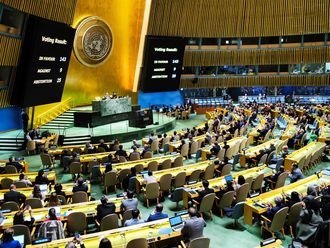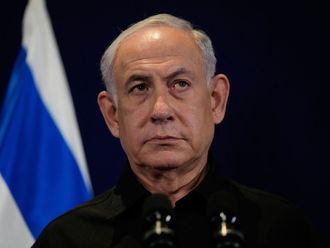Tehran: For months, since the imposition of harsh, US-led sanctions over Iran’s nuclear programme, the country’s leaders have sworn they would never succumb to Western pressures, and they scoffed at the idea that the measures were having any serious impact.
But after a week in which the Iranian currency, the rial, fell by a shocking 40 per cent and protests began to rumble through the capital, no one is making light of the mounting costs of confrontation.
In the Iranian capital, all anyone can talk about is the rial, and how lives have been turned upside down in one terrible week. Every elevator ride, office visit or quick run to the supermarket brings new gossip about the currency’s drop and a swirl of speculation about who is to blame.
“Better buy now,” one rice seller advised Abbas Sharabi, a retired factory guard, who had decided to buy 450kg of Iran’s most basic staple in order to feed his extended family for a year. “As I was gathering my money, the man received a phone call,” said Sharabi, smoking cigarette after cigarette on Thursday while waiting for a bus.
“When he hung up he told me prices had just gone up by 10 per cent. Of course I paid. God knows how much it will cost tomorrow.”
Low value
While only a few people actually need to exchange the rial for foreign currency, its value is one of the few clear indicators of the state of the economy, and its fall has sharply raised the prices of most staples.
In Tehran, many residents spend their days calling on money changers and visiting banks, deliberating whether to sell their rials now or wait for a miracle that would restore the rates to old levels, or for even a modest rally from the panic-driven lows of the last week.
“The fluctuations are so large that nobody knows whether it is better to wait or to change now,” said Ahmad, 65, as he shared a taxi to the west Tehran neighbourhood of Sadeghiyeh.
“I am so fed up,” said Ahmad, a garment seller, who like others here did not want to be identified by his full name for fear of retribution from the authorities. “I want to have a normal life, but from breakfast, to lunch to dinner, everybody only nervously talks of hard currency.”
Like many residents of the capital, Ahmad had tuned in to President Mahmoud Ahmadinejad’s news conference on Tuesday, hoping that he would offer some sort of solution.
Instead, Ahmadinejad attributed most of the rial’s weakness to currency speculators and the sanctions, saying that it is only natural that the currency should suffer when it is possible to sell oil only in small quantities and when it is hard to make international bank transfers. His opponents say he is trying to avoid blame for his own mismanagement of the economy. He even went so far as to threaten to quit.
“He has made a mess, and now he wants to leave us,” Ahmad said of the president. But a passenger in the taxi named Mustafa interrupted. “No,” he said, “most of our leaders are at fault, but they are trying to blame everything on Ahmadinejad.”
Just a day later, on Wednesday, clashes erupted when riot police officers on motorcycles dispersed sidewalk money changers near Tehran’s main bazaar. The government has accused them of deliberately manufacturing the currency crisis.
While life seemingly returned to normal on Thursday, the outburst of public anger exposed the deep feeling of hopelessness that has taken hold among many Iranians.
Mismanagement
Experts are divided about whether the crisis has been caused more by Tehran’s longtime mismanagement of the country’s economy or by the US-led sanctions, which have been imposed over Iran’s refusal to halt a nuclear programme that the West suspects is a cover for developing weapons. Whatever the cause, members of the once-vibrant middle class have turned into cynics, many of whom say they might be alive, but are not living.
For Maysam, the son of a man who was killed in the Iran-Iraq war, a decade of relative prosperity and technological innovations had enabled him to travel widely and had turned him into a prominent blogger and critic of the system that his father had died defending.
Instead of hoping to die on a battlefield, he had planned to run his own Internet startup company. But those dreams have been shattered.
“We can’t even think of the future, of tomorrow, the day after, or the next week,” Maysam said.
Foreign trips are out of the question, as even the price of a cup of coffee in Istanbul — favourite destination for Iranians — has tripled when calculated in rials.
Parents of the legions of Iranians studying abroad are calling their children back to Iran, as rents and college fees in countries like the Philippines and Malaysia have become unaffordable.
“I have told my son to come home,” said Shabaz, 60, who owns a printing house. “We are all losing. His future is gone; I won’t ever witness his graduation; and he won’t find a job.”
At Tehran’s currency market, traders quietly started buying and selling again after the raid on Wednesday, though few people were willing to part with dollars. While government officials announced that the rial would strengthen as soon as they had their own foreign currency exchange centre up and running, many traders were sceptical. “It all comes down to this,” said a trader named Akbar.
“As long as sanctions continue, the rial will continue to lose value.”













